Good evening ladies and gentleman and thank you Ken and Yvonne for inviting me to talk to you about……….. ‘The tale of an Piracy, Discovery, Heraldry, Royalty and Embroidery and of course not forgetting Whidborne Manor and some of it’s occupants.’
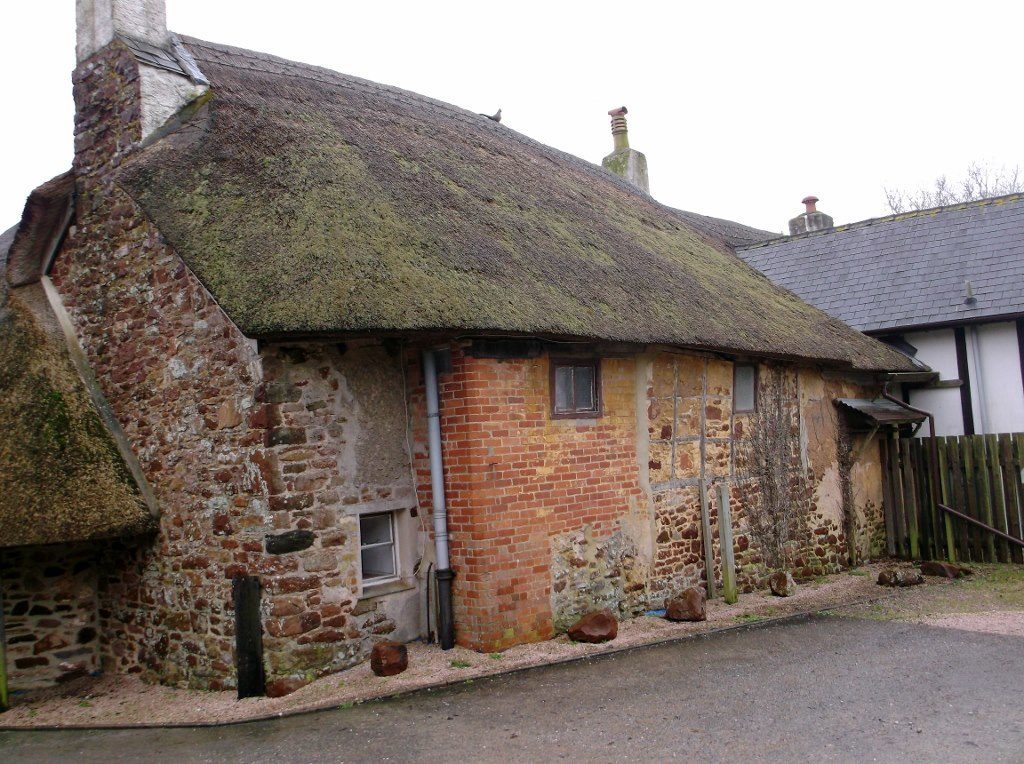
Back of Whidborne Manor
Whidborne Manor formally known as Ash Hill Farm, was first built between 1450-1480, but the area around the building goes back further. Back in the 10th century The Celts and Anglo-Saxons were hard at war and by 925 AD a monastery was built for the Benediction Monks, on the site where the Bishops Palace is now.
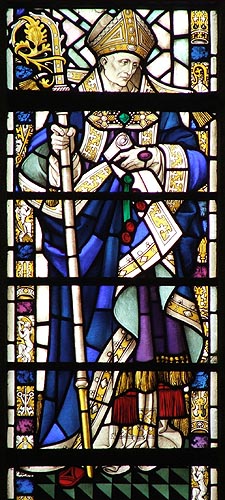
Bishop Leofric
Then in 1050 Edward the Confessor made Leofric the first Bishop of Exeter. Leofric did not care for the Benedictine Monks and had them removed and the building was re-arranged to form the Bishop’s Palace.
There were many more Bishops appointed including Bishop Simon of Agulia, an Italian who was consecrated by Arch-Bishop Stephen Langton on 1st October 1214. Bishop Simon also assisted with the coronation of Henry 111 and followed Bishop Leofric’s rules and made all the Cannons take their food at one common table. He ruled wisely and was beloved by all.
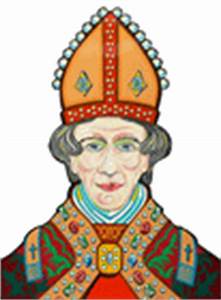
Stephan Langton
Stephan Langton was a very important Arch-Bishop as not only did he come from Exeter, but he divided the Bible into chapters and verses. He also, along with the Barons, conjured up the Magna Carta, which was sealed by King John on the 15th June 1215.
Bishop Bronscombe (1258-1280) was born to poor parents, but by grit and hard work and of great character, rose to his position in 10 years. After he was made Bishop of Exeter, he dedicated 88 rebuilds or altered churches and he often resided at the Bishop’s Palace at Old Walls.
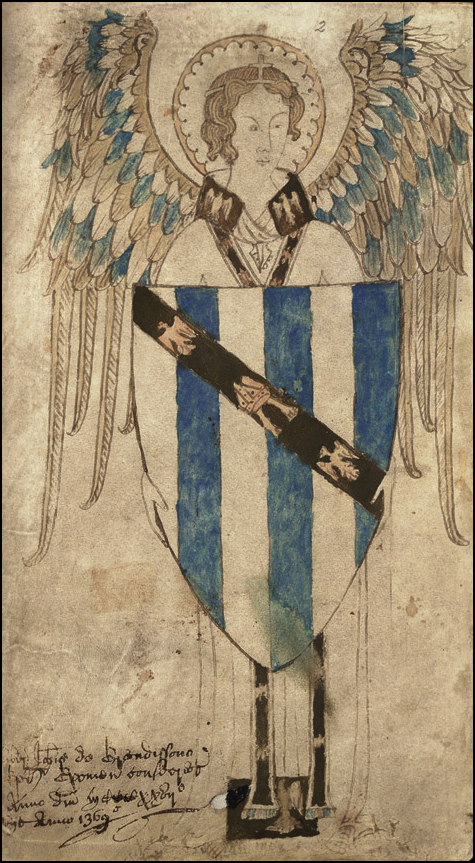
Grandisson Coat of Arms from a Psalter in the British Library
After Bishop Bronscombe left, the Palace fell into disrepair and in 1328 Bishop Grandisson petitioned his friend Pope John XX1 that he might gain possession of the Palace and farm, to keep for himself and his successors, giving the reason that the seat, when vacant would be retained by the crown. If it was not vacant, then the Bishops would have somewhere to lay their heads. He got permission and started to rebuild the Palace.
In 1550 Bishop Veysey was compelled by Edward V1 to dispose of the rural manors including Bishopsteignton and by 1611 all the Manors had been leased to Richard Manton of Middle Temple in London.
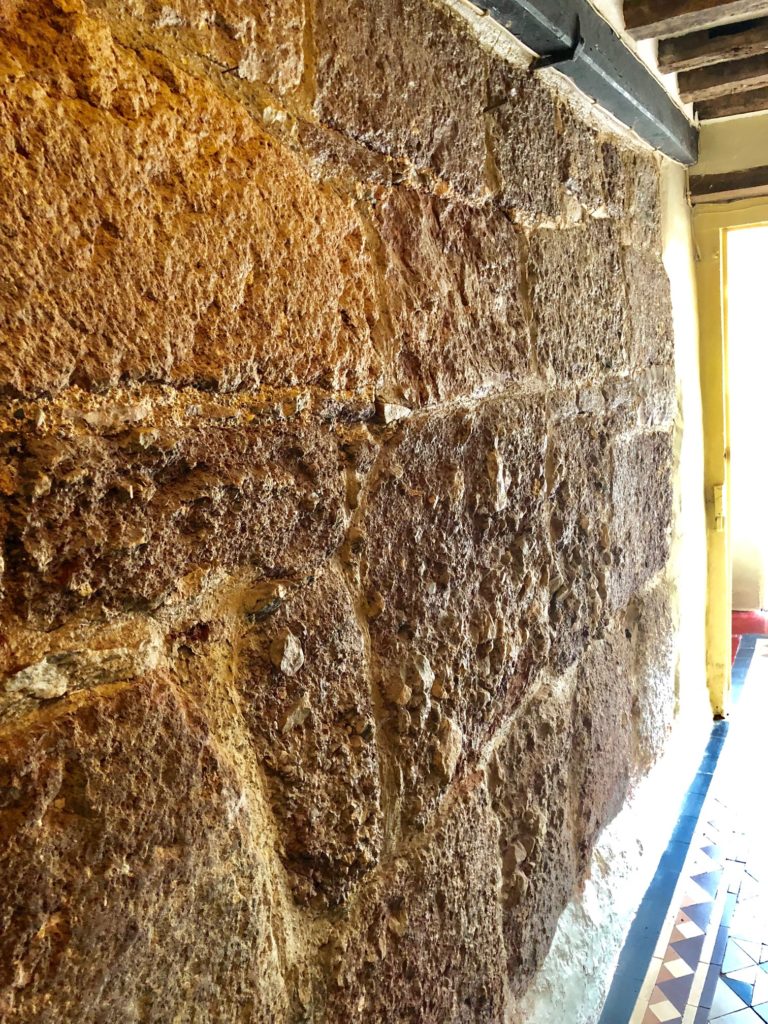
Old walls at Whidborne
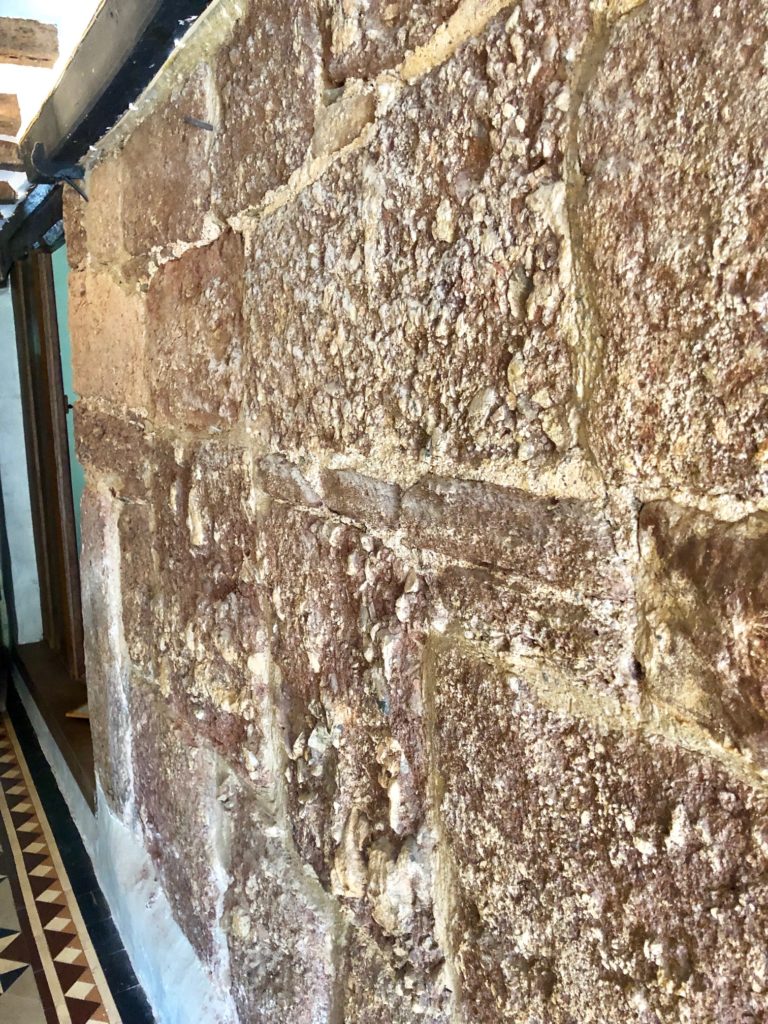
Old walls at Whidborne
The Palace is now amongst farm buildings belonging to Ashill Farm which for some 250 years was the home to the Whitburn family. It is recorded that a member of the Whitburn family Thomas Whitburn of Ashill Farm, destroyed the chapel in the Bishop’s Palace and took the stone for repair to his house and farm buildings (I have some in my house) The Whitburn family were stewards of the Palace Estates during the later years of the occupancy of the Bishops.
In 1612 The Earl of Salisbury sells to Thomas Whitburn all of Ashill and Old Walls, including the coppice-hold cottage that was in the occupation of Michael Whitburn at the time.
Over the years the family name is recorded in various spellings, but for the purposes of this article it will be Whitburn.
The name Whitburn comes from the old English HWIT and BEARN… meaning “A fair child”. There would appear to be in the order of seventeen distinct variations of the present name of Whitburn, but what must be remembered however, is that many of the different spellings came as a result of parish register entries. Written by clerics in either Latin or court secretarial script and the name would have been spoken in the English language or dialect of the county or district. The cleric or scribe would have interpreted and written the name to their best ability and spelling of names through illiteracy, could not be challenged.
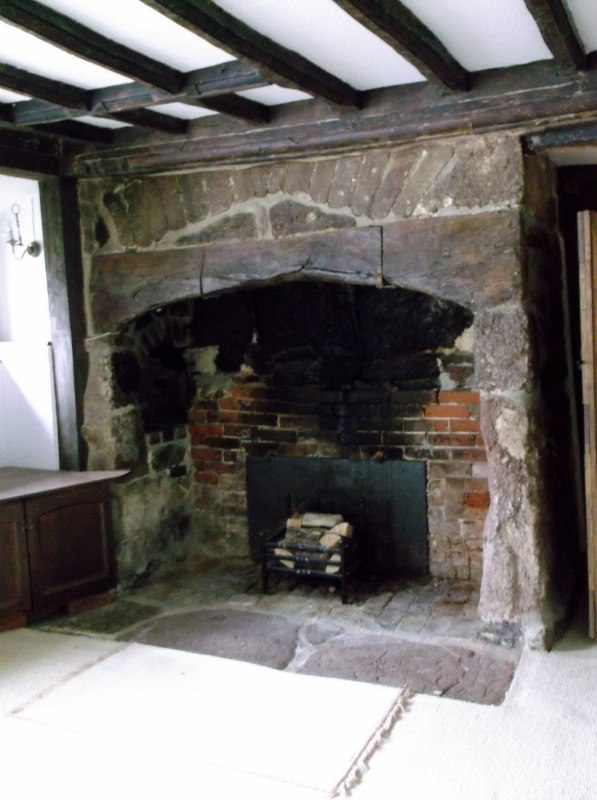
Ashill-Farm Fireplace-
The farm house was first built in 1450-80 as a Devon Long House, with a central area where a fire would burn, which was open to the roof area. Although this building was a farm house, many of the Whitburn family were sea-faring merchants who sailed from Exmouth, Topsham and Exeter. It was not until the late 16th and early 17th century that Sir Richard Whitburn according to HM Customs records for the ports of Topsham, Exeter and Exmouth, identify the registration of the following:-
Sir Richard sailed on the Mayflower (50 tons) There many Mayflower named ships…….registered in the port of Exmouth and the Labourer. He was also the Master/Owner of the Endeavour (140) tons which was registered in the port of Topsham. He made his first voyage to Newfoundland at the age of 18 years and continued to sail there along with his younger brother John, dealing mainly with fish and train (whale) oil.
Richard Whitburn was also known for his travelling expeditions to foreign places from the age of fifteen. Whilst apprenticed to a merchant adventurer of Southampton taking ships also from Teignmouth, Exmouth and Budleigh Salterton and travelled to several countries including France, Spain, Italy, Savoy, Denmark, Norway, Russia or the Baltic States as well as Newfoundland, in search of new commodities, but he appeared to spend more time travelling to the fishing grounds off the coast of Newfoundland.
He also served in a ship of his own and lead four ships against the Great Armada in 1588 under Lord Admiral Thomas Howard, 1st Earl of Suffolk. He then spent the next 30 years in cod fishing off Newfoundland and assisted the pirates Peter Easton and Henry Mainwaring to seek pardon from James 1st of England.
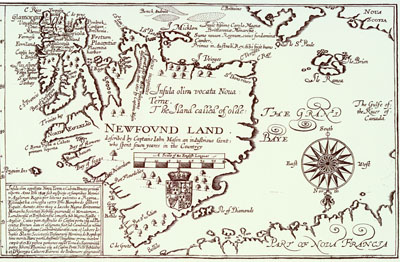
Newfoundland map
On the 11th May 1615 Richard Whitburn sailed from the port of Exeter in the Endeavour, bearing a commission from the Admiralty, to hold courts of justice in Newfoundland. This was the first attempt to hold a formal court of justice in the country. On June 4th 1615, he anchored in an area named Trinity Harbour. From here he went to other harbours to call upon the masters of other English Ships. It was in these anchorages that he held courts of enquiry, into the disorders committed on the coast and then transmitted back to the Admiralty in England.
In 1617 Richard Whitburn was sent for by Sir William Vaughan, who was a Welsh writer in both English and Latin and who promoted colonization in Newfoundland. He had already purchased some land in Newfoundland from the London and Bristol Company and in 1617 sent Welshmen to Renews in Newfoundland to establish a permanent colony and in the following year, 1618, Vaughan sent out a second batch of colonists under the command of Richard Whitburn, whom he appointed Governor for life of the undertaking. He did this from 1618-1620 when Vaughan abandoned the venture.
But when Whitburn anchored in Renews, he found the colony in a very bad state. The settlers had not even constructed satisfactory shelters. So in an attempt to reorganise the settlement, Whitburn sent all but six of the unfit colonists back to England. The ship Golden Grove, which belonged to Sir Richard Whitburn proved to be a disaster, due to the idleness of the colonists in fact it nearly ruined him. Soon after Richard Whitburn returned to England he received a knighthood from James 1.
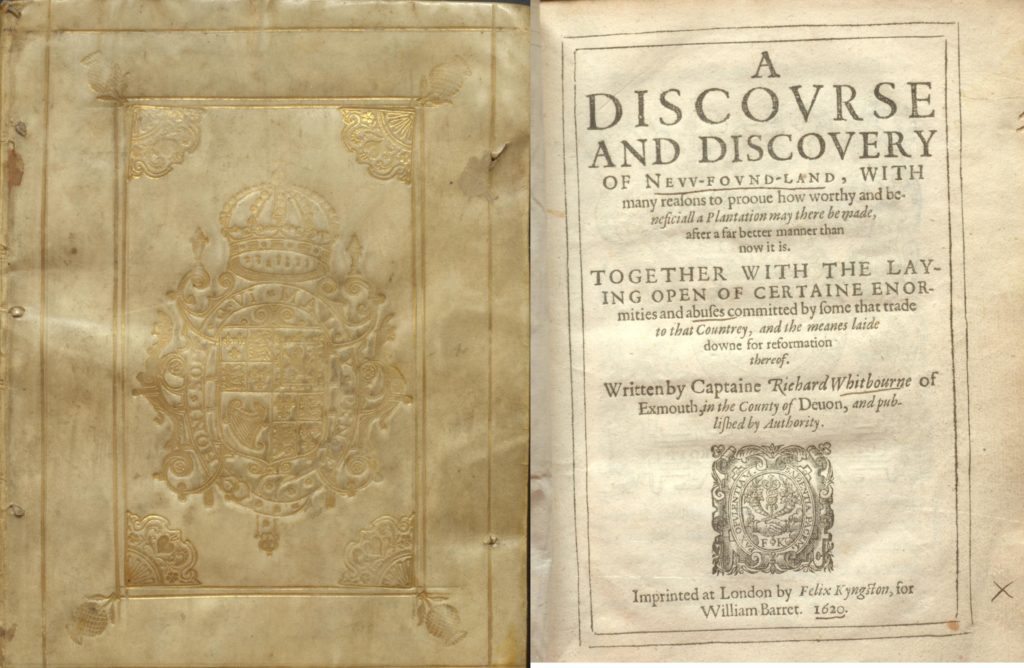
Whitburn book
In 1620 Sir Richard Whitburn published a book “ A Discourse and Discovery of Newfoundland” in order to promote colonisation on the island of Newfoundland. He gives a good account of the natives in the area and in particular of their ability to take bark from the trees and make it into cooking utensils. He also gives a good account of the flora and fauna of the country and of the many wolves and wild creatures that come to the waters edge, without fear of ships and people.
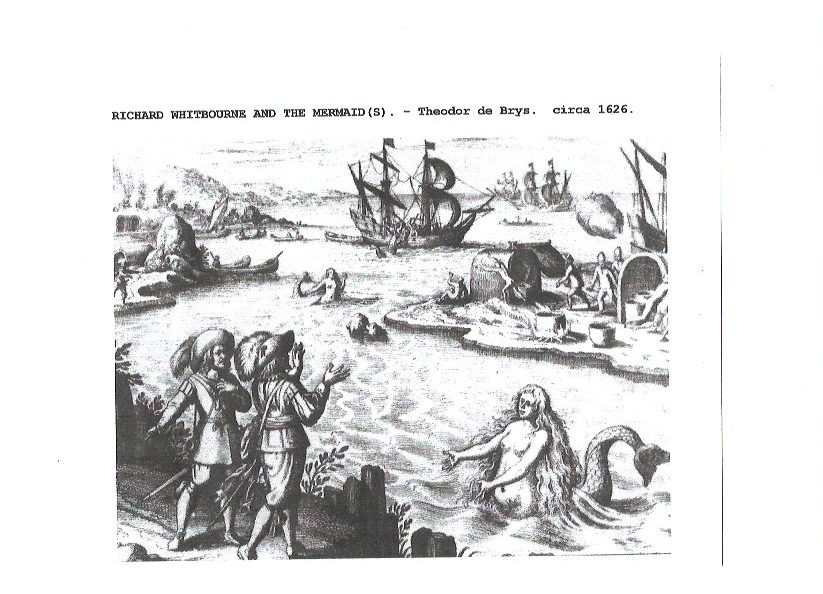
Mermaids
He states in his book about a mermaid that he saw
and I quote………
Now also I will not admit to some thing of a strange creature which I first saw in the year 1610 in a morning early as I was standing by the river side the Harbour of Saint Johns which very swiftly came swimming towards me looking cheerfully on my face as it had been a woman by the face, eyes, nose, mouth, chin, ears neck and forehead. It seemed to be so beautiful and in those parts so well proportioned, having around the head many blue streaks resembling hair, but certainly it was no hair, yet I beheld it long…
and so it goes on …..
On the 14th May 1613, Whitburn marries for the second time to the widow Margaret Easton of Coombe in the parish of Bishopsteignton. Her late husband was Peter Easton, (whom I mentioned earlier) a pirate and buccaneer and probably as a result of this allegations were made that Whitburn was hanged for piracy and his possessions sequestered into Chancery. It is true that in 1611 he encountered Peter Easton who requested Whitburn to intercede on his behalf with the authorities in England to arrange a full pardon for his past deeds. To this Richard Whitburn agreed but only on condition that Easton released all the ships he had taken under his control. Easton would not agree to this, but did release a ship belonging to Captain Rashly of Foy in Cornwall, which Easton had appropriated off the coast of Guinea.
Whitburn provided men to collect the ship and arranged a pardon at court for Easton.
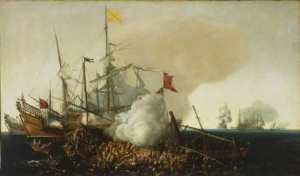
Cornelis Vroom Spanish men of war engaging Barbary Corsairs
Peter Easton was a loyal Englishman who turned pirate. He had a well equipped fleet of war like ships and his intensive raids on both English and foreign ships earned him the title of Arch-Pirate.
In the early 1600’s he was also known as Pirate Admiral and amassed a small fortune off the coast of Newfoundland, while working as a pirate.
He had a crew of almost 5,000 and wreaked havoc up and down the coast of North America and nobody could stop him.
By 1610 he was then referred to as Notorious Pirate who had become the most powerful pirate in the Western Hemisphere. He was extremely wealthy and had a fleet of forty ships, which were stationed near Bristol at the mouth of the Avon. From this site, he could hold up all the traffic in the English channel
By 1612. Easton had amassed a fortune, that would last him a lifetime.
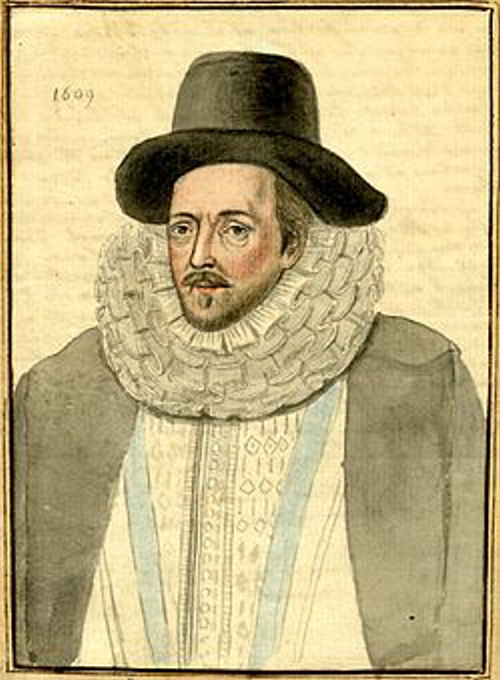
Sir Henry Mainwaring
In 1614 Whitburn was to meet the infamous Sir Henry Mainwaring, who was the most feared pirate of the time, having sailed to Newfoundland saying the region was the best for recruiting a pirate crew.
Mainwaring attended Oxford University getting his BA in 1602. He was then admitted as a student to the Inner Temple, which was a law college in 1604. What he did for the next few years is unclear, but what we do know is that he received a commission from James 1st to hunt pirates in the Bristol Channel, and even sailed to Newfoundland to capture Pirates.
He used Peter Easton’s old base at Harbour Grace in Canada as his pirate base and raided Spanish, Portuguese and French ships.
When he left Harbour Grace he took with him Carpenters, ammunition, 10.000 fish and 400 men , and even became head of the Pirate fleet, based off the coast of Morocco. James 1st wanted peace with the Spanish and sent a message to Mainwaring to stop his piracy. Saying, If he refused, the King would send a fleet to destroy him. Then 1615 he was sued in the High Court of Admiralty for his attack, but as Mainwaring was loyal to the Crown, he was offered a free pardon by James 1st in 1616
He then gave up piracy and joined the navy as a lieutenant. He was then knighted in 1618, after rescuing a Newfoundland trading fleet captured by pirates near Gibraltar Then in 1620 he was elected MP for Dover and ended his naval career as Vice–Admiral in 1639
Sir Henry Mainwaring even wrote a book on how to capture pirates and had one copy bound and used gold lettering for the beginning of each chapter, to present to the King as a thanksgiving, possibly on the day he was knighted.
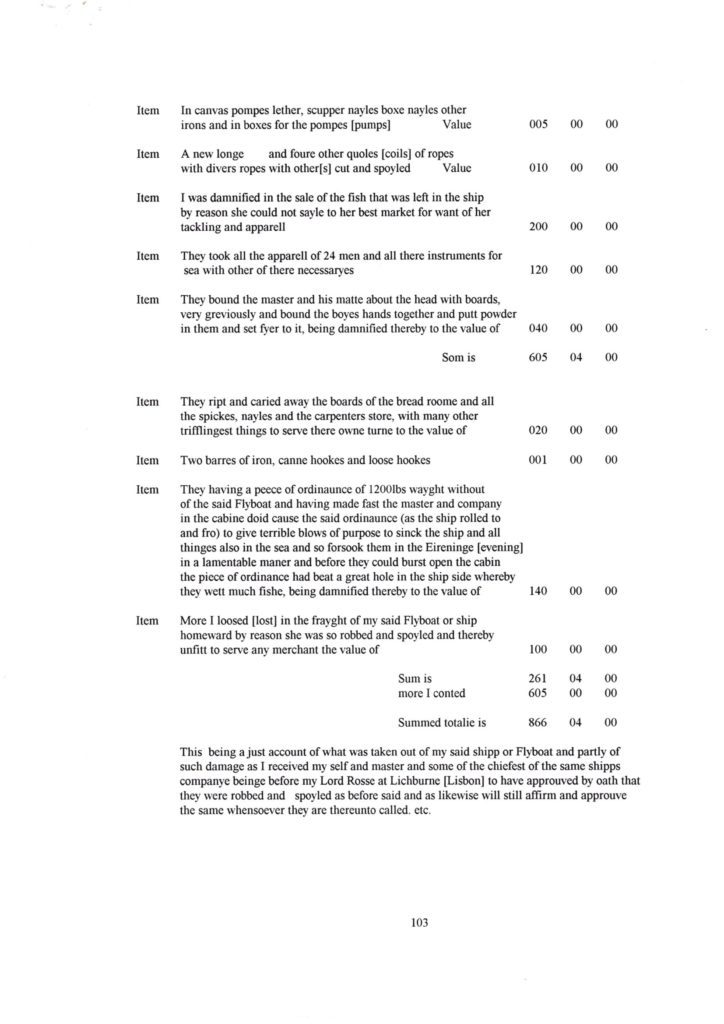
Insurance Claim 1
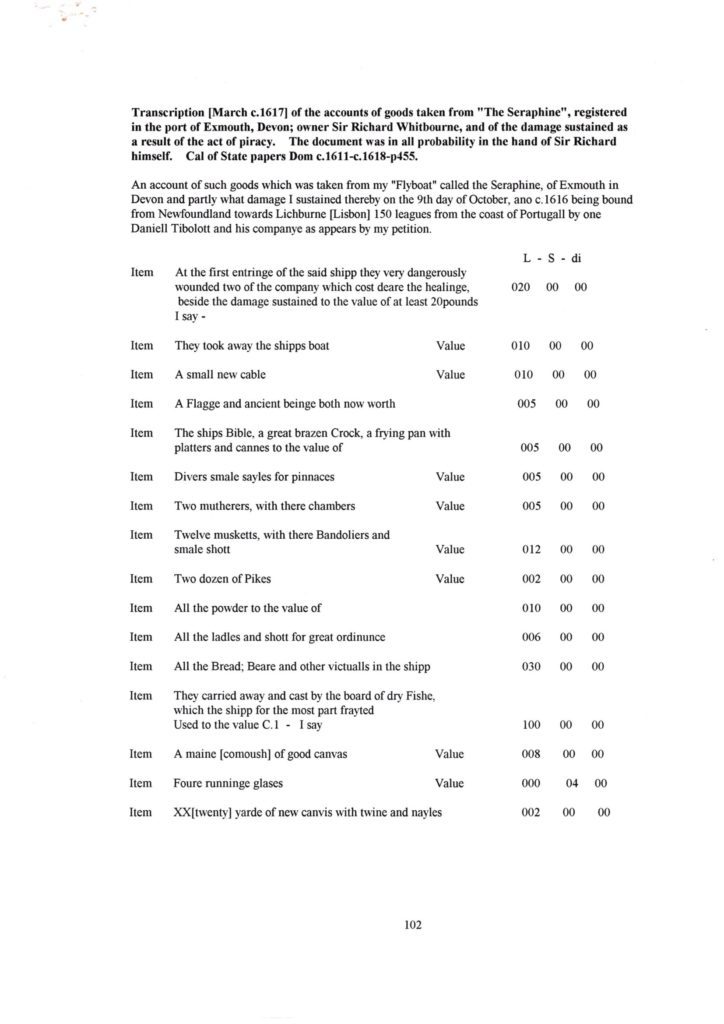
Insurance Claim 2
Sir Richard Whitburn himself suffered at the hands of pirates and in 1616 en route to or from Newfoundland, a ship of Whitburn’s was rifled by a French pirate of Rochelle, one Daniel Tibolo by which he lost more than £860, a quite considerable sum of money by today’s standards. Apart from the ship that was taken by Daniel Tibolo, another of Whitburn’s ships was taken by a privateer.
Sir Richard Whitburn did not discover Newfoundland, but like a number of West Country mariners he certainly played a big part. In fact a town and railway station were named after him.
We suspect that Sir Richard died on a foreign voyage and is buried in Teignmouth near to his birthplace in August 1635.
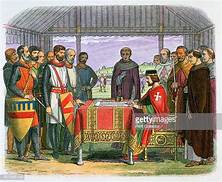
King John sealing Magna Carta
As I said earlier, Archbishop Stephan Langton, helped to conjure up the Magna Carta, with the help of all the Barons, It took a few years to do so, but they met in the Magna Carta Trust towns of St Albans, Bury St Edmunds, Canterbury, Runnymede, City of London and Hereford. Then on 15th June 1215, King John sealed the Magna Carta on Runnymede Meadows. Unfortunatly King John after that, was not happy, as he was now below the law, where before he could do anything. So he got Pope Innocent to annul it, which he did three month later. The country then went into civil war and by October 1216, King John did the best thing he ever did……..he died !!!! His son Henry 111 was then left as an orphan, because his mother who was French, went back to France and remarried, had more children and never set foot in England again. So William Marshall (one of the Barons) and Ammeric (who is mentioned in the first line of the Magna Carta) took him under their wing and by 1225 King Henry 111 sealed the next Magna Carta There was another sealing of the Magna Carta in 1265 and the last one in 1297 which was sealed by Edward 1. The latter was solely for The City of London, giving laws solely for the City of London and is the only one which still has its seal in tact.
The embroidery, which I was commissioned to do, consists of 12 panels all A1 size. My brief was to tell the story, how we spread law and order around the world from 1215 to the present day. Therefore I had to take in the British Empire. I then learnt that all the Magna Carta Trust Towns wanted a panel and also one of all the shield of all the barons that were there for the sealing. There were 25 of them and this was just in case there was a split vote. The first Magna Carta which was sealed in 1215, gave two clauses no 7 and 8 in which I feel was the start of Women’s Lib !! you had to be high born, not a peasant and stated that If your husband died you would inherit his money straight away and the other clause stated, if your husband died, you did not have to remarry if you did not want to.
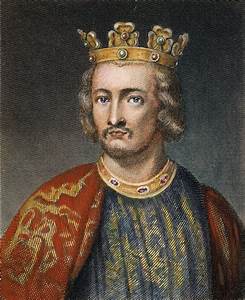
King John
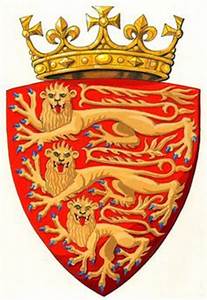
King John’s coat of arms
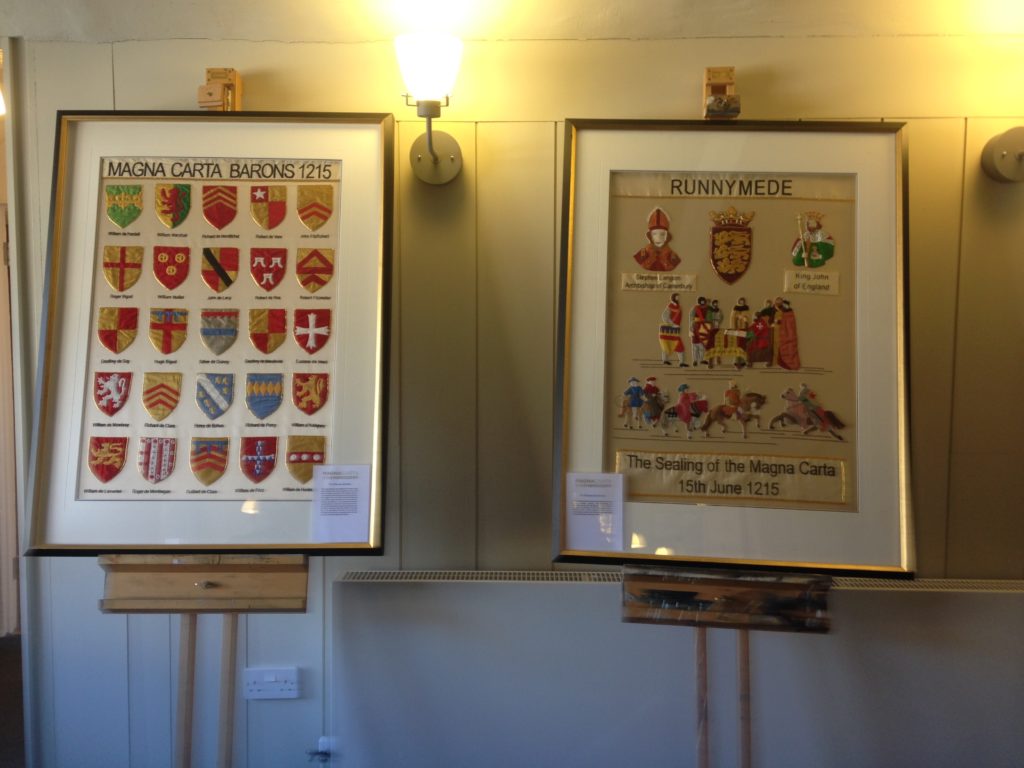
Magna Carta Embroidery
I was also asked to embroider pennants for the Magna Carta Garden, for Chelsea Flower Show in which the garden won a Gold.
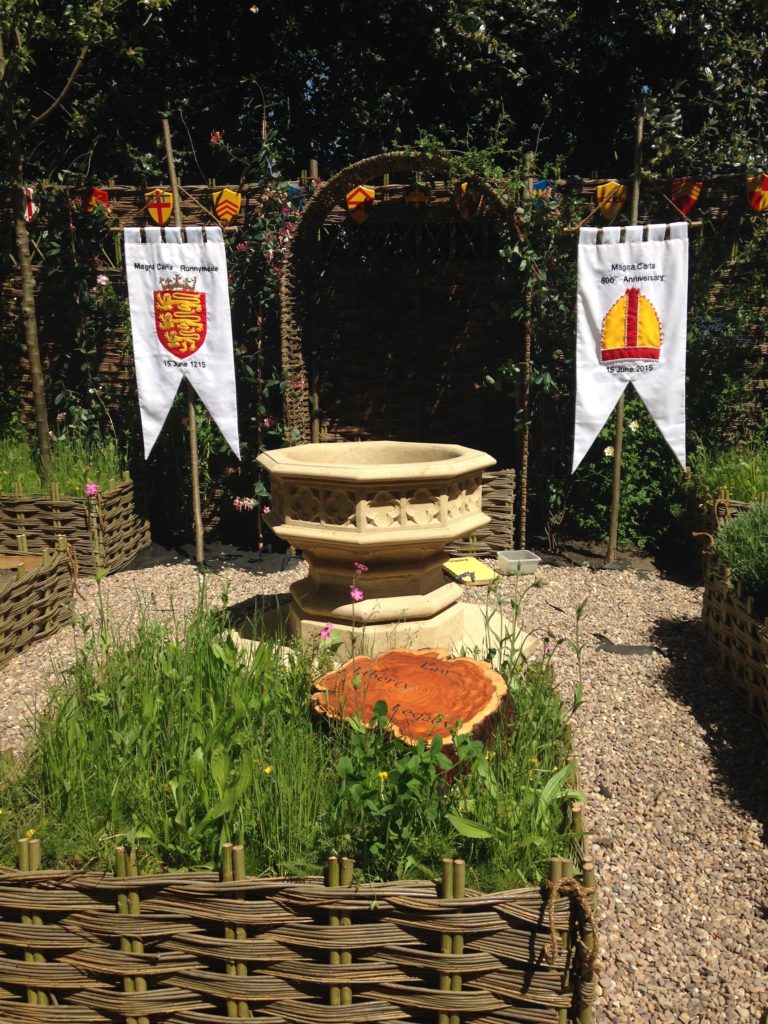
Chelsea Flower Show Pennants
I was also part of a team that embroidered The Duchess of Cambridge’s wedding dress.
I am also a Broderer at Southwark Cathedral and we embroidered new vestments for the Bishop of Southwark and his area Bishops which are Woolwich, Kingston and Croydon. The last lot of vestments that were made for the Bishop, was in 1905, so he thought to have some new ones for the Queen’s Diamond Jubilee would be good.
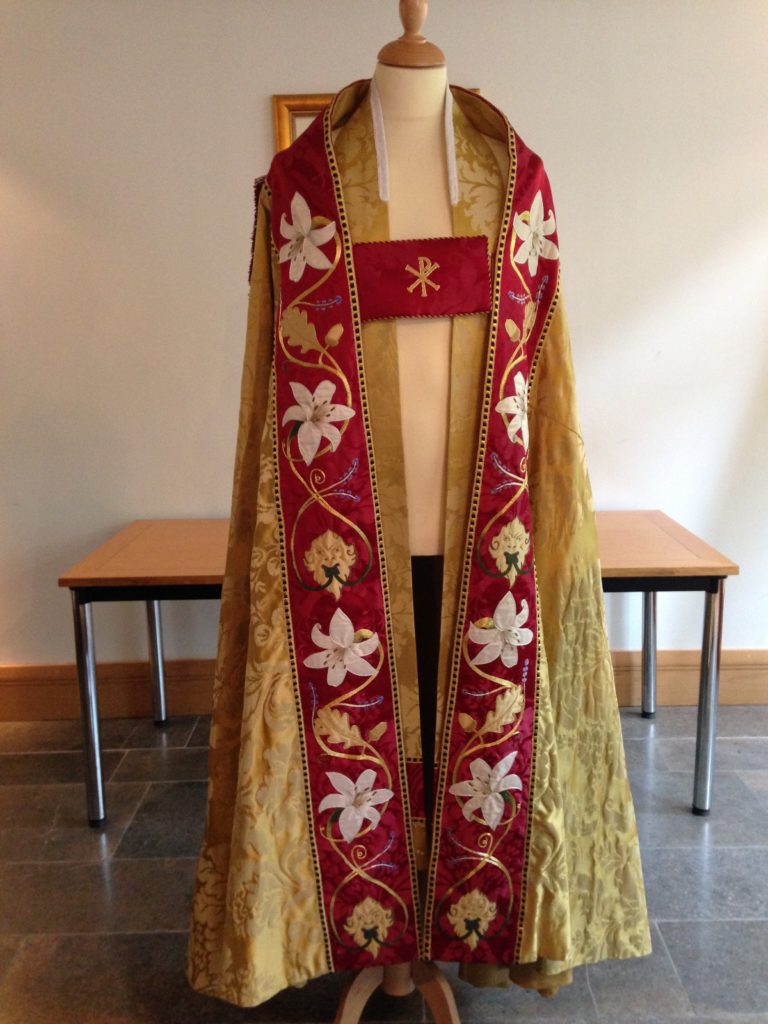
Bishop of Southwark’s vestments
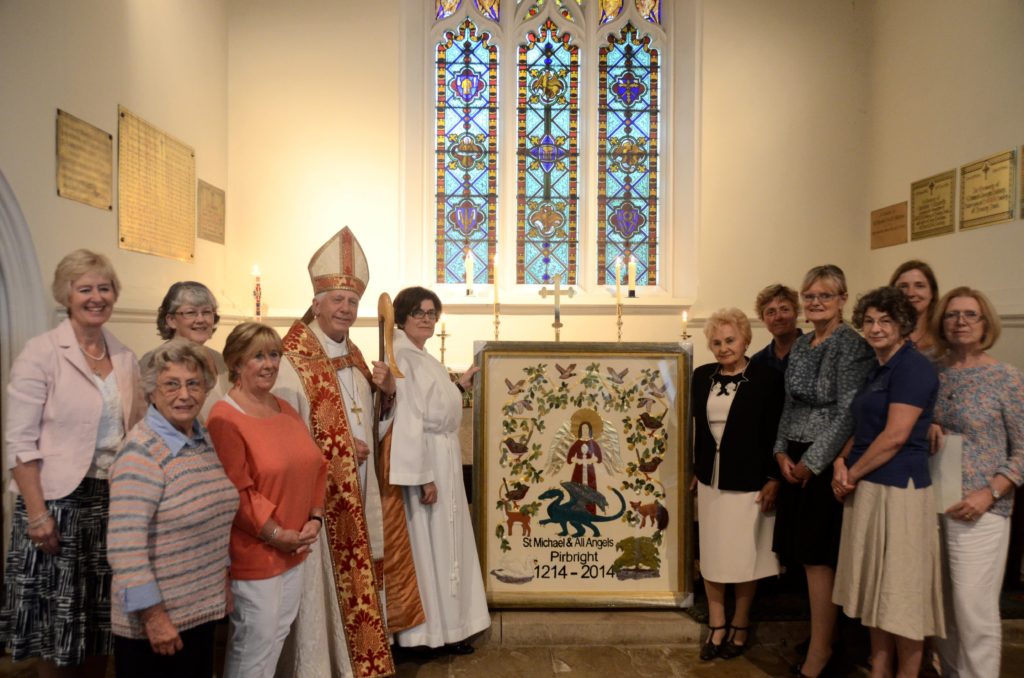
Pirbright Church
Also when I was embroidering the Magna Carta panels I was asked to embroider a very large panel for the 800th anniversary of a church being on the same site in my village of Pirbright in Surrey. This was then dedicated by the Bishop of Dorking.

Back of Whidborne Manor
In 1641-42 The Protestation Roll/Return – was for all males aged above 18 who were asked to sign and swear an oath by order of the house of commons to the protestant religion. In each parish, their names were inscribed in a list and sent back to parliament. Typically a local official wrote the names, although in some areas the signatories wrote their own name.
The Devon Protestation Returns lists Thomas Whitburn as a Parish constable. It also lists John, Richard and Richard Jr as villagers. Thomas Whitburn the grandson of Sir Richard was born in 1627 in the parish of Bishopsteignton and moved to Exeter in his teens in support of the Whitburn’s family merchant interest which was in the Port of Exeter.
In the late 1600’s Richard and Thomas Whitburn (Great Grandson’s of Sir Richard) sell Ashill Farm to Protodorus Finney. A cottage and Old Walls, plus 25 acres. The cost was five shillings and one peppercorn as rent. Protodorus married into The Neck family in 1699 to Jane. This family were mariners and sailmakers, who lived anywhere from Lambeth to South Wales and South Devon.
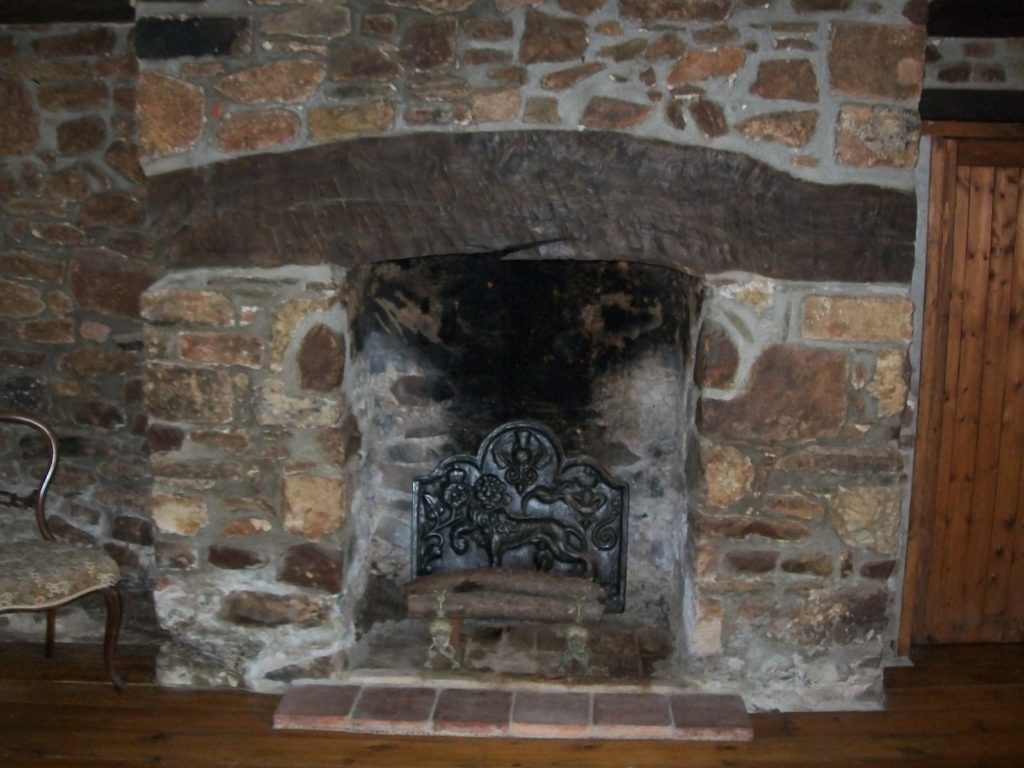
Hearth
In 1718 – Thomas Comyns was churchwarden for Ashill Estate and married Mary Lear who was the daughter of the 2nd Baronet of Powderham. This began the ownership of the Ashill Estate by the Comyns family
During this period they also acquired the Advowson – which is the right to recommend a member of the Anglican Clergy for a vacant position. There were also other properties they owned including “Wood”. There were many tenants of the Ashill Estate under the ownership of the Comyns family
In 1801 John Furse was churchwarden for the Ashill Estate and was also tenant of Ashill Farm and the Furse family continued to live at the farm house until 1866.
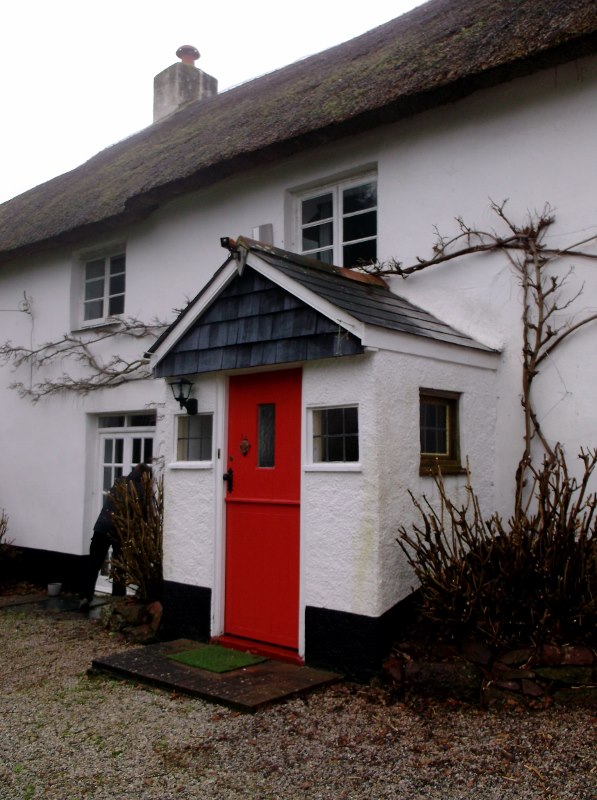
Front of Whidborne Manor
There continued to be numerous tenants residing at Ashill Farm under the ownership of the Comyns family …. then in 1917 Ashill farm was sold to William Henry Dawe & Sons which came with 240 acres. In the 1930s William Dawe bought a neighbouring farm with another 200 acres,then in the 1950s The Dawes family bought another neighbouring farmer’s land which came with another 200 acres, ending up with 640 acres in total.
In 1994 Ashill farm is renamed Whidborne Manor after Ken Dawe decided to part company with his business partner and cousin Roger and the farm was split. The name Ashill Farm was retained for Roger’s business.
In 1999 Ken Dawe sells Whidborne Manor to Jon Dykes when it became a Bed and Breakfast. Then in 2014 Jon Dykes sells Whidborne Manor to Katherine Hanson and in 2017 Katherine sells to ourselves.
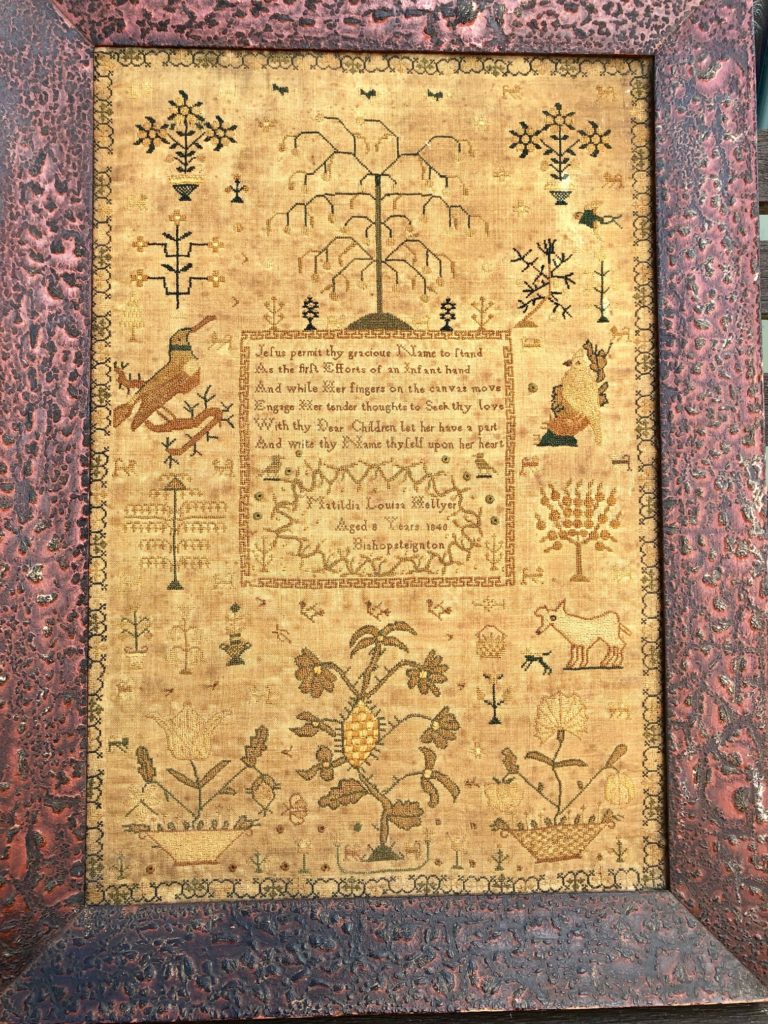
Matilda Hellyer’s sampler
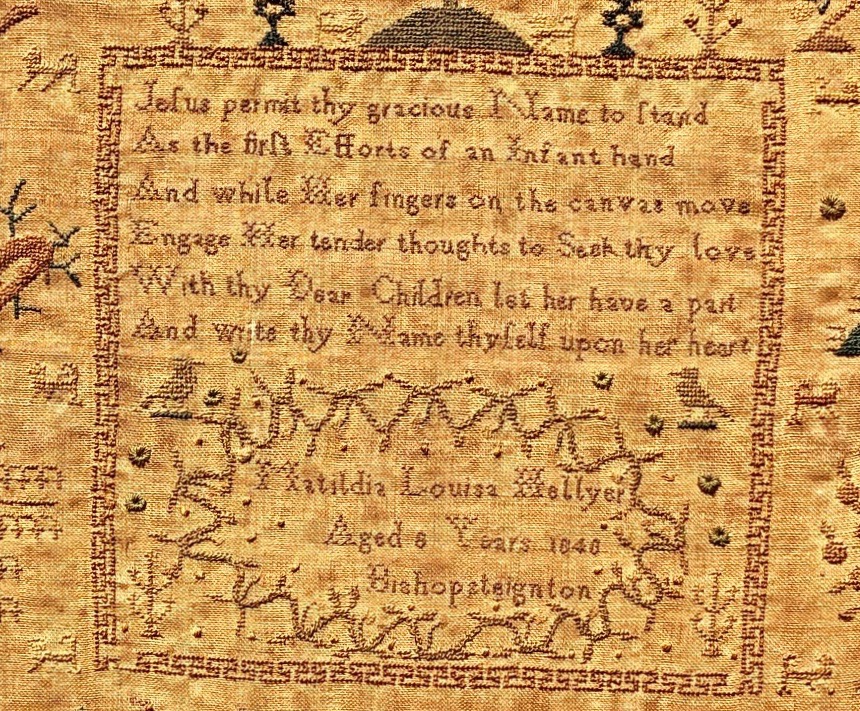
Sampler verse
This sampler was embroidered by Matilda Louise Hellyer at the age of 8 years in 1840. She lived in Bishopsteignton and was the daughter of a tailor and we suspect that her mother was a seamstress.
The embroidery is exquisite for her age and the literacy of her poem is perfect.
She writes…….
Jesus permit my gracious name to stand
As the first efforts of an infant hand
And while her fingers on the canvas move Engage her tender thoughts to seek thy love With thy dear children let her have a part And write thy name thyself upon her heart.
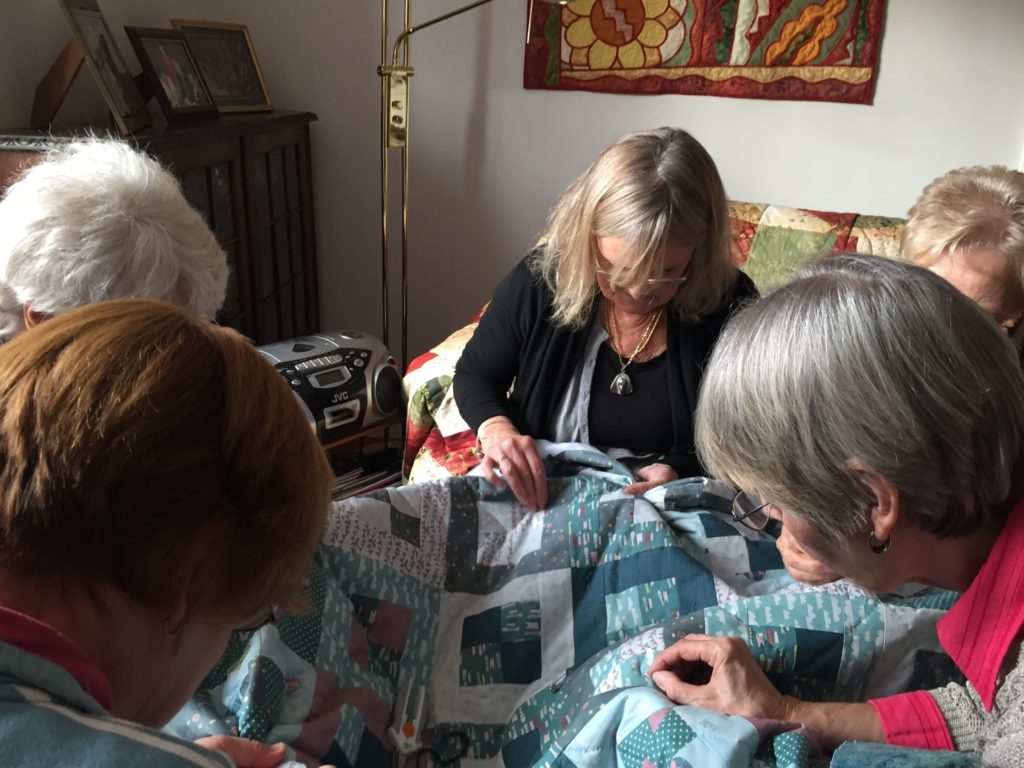
Riverside Quilters
Last but not least a photo of yours truly along with the Riverside quilters, finishing off a quilt that we made, to raise money for the victims of the Grenfell Fire.
